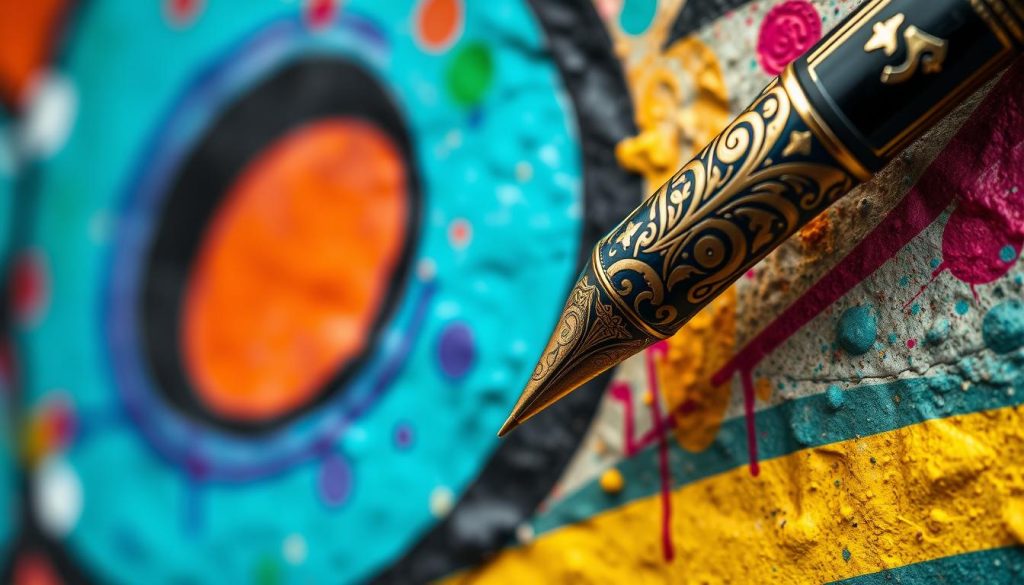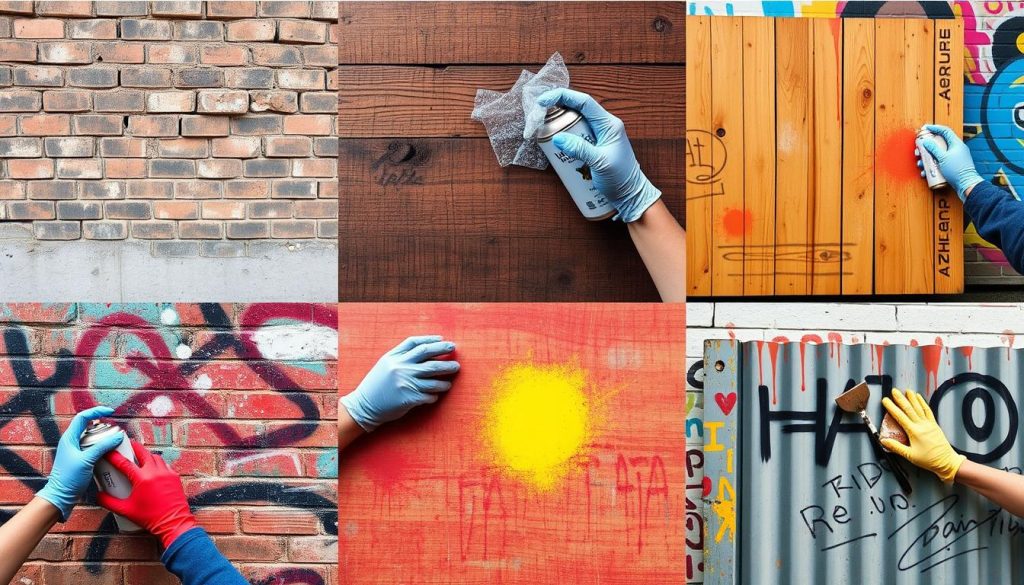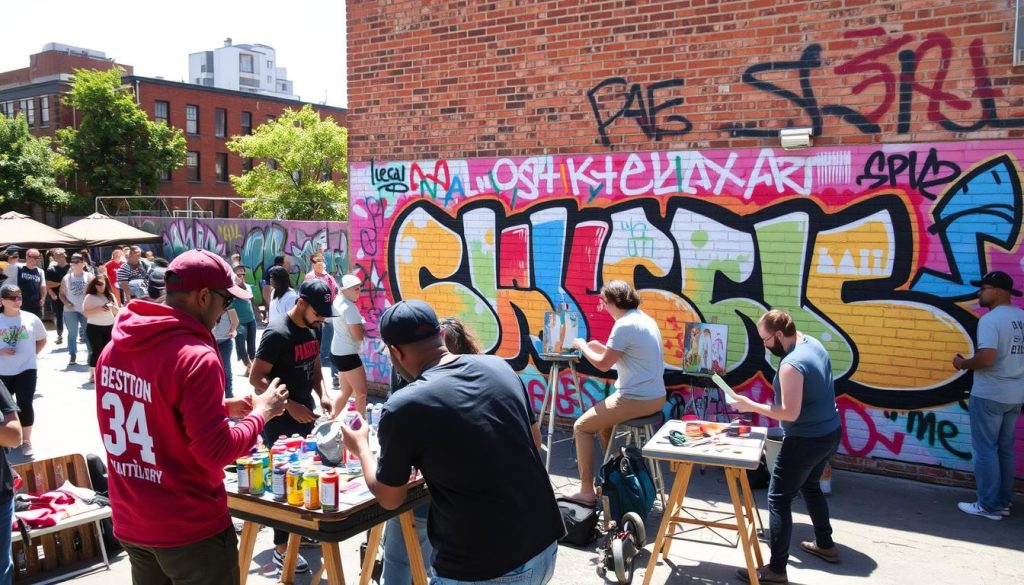Welcome to the world of calligraphy and graffiti. Here, art and creativity meet in a special way. Using a calligraphy pen for graffiti adds a personal touch to your art. It’s a fun and rewarding experience for beginners and experienced artists alike.
With the right techniques and tools, you can create stunning graffiti art. It shows your personality and style. First, you need to know the basics of calligraphy pens and how to use them for graffiti.

Introduction to Calligraphy Pens
Calligraphy pens are loved by artists and writers for their versatility. They add texture, depth, and emotion to graffiti art. By learning to use a calligraphy pen for graffiti, you can create intricate designs and patterns that show your individuality.
Key Takeaways
- Learn how to use a calligraphy pen for graffiti step by step to unlock your creative potential
- Understand the basics of calligraphy pens and their applications in graffiti art
- Discover the benefits of using a calligraphy pen for graffiti, including added texture and expressiveness
- Get started with the right techniques and tools to create stunning graffiti art
- Practice and patience are key to mastering the art of using a calligraphy pen for graffiti
- Experiment with different styles and techniques to develop your unique voice and style
Understanding Calligraphy Pens for Graffiti Art
Choosing the right calligraphy pen is key for graffiti art. To start, you need to know about the different pens and their features. Calligraphy pens include brush pens and dip pens, each with its own benefits.
For graffiti, pens that offer flexibility and wide line widths are best. Graffiti calligraphy focuses on expressive movements, unlike traditional calligraphy. Knowing this helps you pick the best pen for your art. Here are some pens to consider:
- Brush pens: These pens have flexible tips that mimic a brush. They allow for varying line widths and expressive strokes.
- Dip pens: These pens use a nib dipped in ink. They offer high control and precision.
When picking a pen for graffiti, look for ink flow, tip flexibility, and durability. The right pen and practice can unlock your creative potential. You’ll create stunning graffiti art.
Remember, practice is key. It may take time to master using a calligraphy pen. But with patience and dedication, you can create amazing graffiti art.
| Pen Type | Features | Benefits |
|---|---|---|
| Brush Pen | Flexible tip, varying line widths | Expressive strokes, dynamic movements |
| Dip Pen | Nib, ink flow control | Precision, control, intricate details |
Essential Materials and Supplies
To make stunning graffiti with calligraphy pens, you need the right materials for graffiti. You’ll want high-quality paper or surfaces that can handle the ink or paint. Knowing the best materials for your project will make your experience better and your artwork look great.
When picking materials for graffiti, think about the ink or paint that works best with your pen. Some pens need specific ink types. You might also need tools like brushes or sponges for mixing colors or textures.
- High-quality paper or surfaces
- Ink or paint suitable for your calligraphy pen
- Tools for mixing colors or creating textures
Investing in the right materials for graffiti lets you make unique and stunning art. Your skills and style will shine through. Always choose top-notch materials to improve your experience and art quality.
With the right materials and a little practice, you can create amazing graffiti art with calligraphy pens.
Mastering Basic Calligraphy Pen Techniques
To get good at using a calligraphy brush pen, you need to learn the basics. This includes how to hold the pen and where your hand should be. These things help you control the pen better. Practice these techniques to get better at using the pen.
Learning the basics is the first step to getting better with a calligraphy pen. Basic strokes and movements are the foundation of calligraphy and graffiti. Knowing how to change line widths and styles is key. Also, learning to control the pressure helps you make fine details or broad strokes.
Proper Grip and Hand Position
Having the right grip and hand position is crucial for mastering calligraphy pen techniques. It helps you control the pen and get the results you want. Start by practicing the right grip and hand position to use the pen well.
Basic Strokes and Movements
Basic strokes and movements are the base of calligraphy and graffiti. To get good at these, practice the following:
- Vertical strokes: up and down movements
- Horizontal strokes: side to side movements
- Diagonal strokes: angled movements
Pressure Control Techniques
Controlling the pressure is key to getting the right effects with a calligraphy brush pen. Practice using different amounts of pressure to change line widths and styles.
By mastering these basic techniques, you’ll be well on your way to using a calligraphy brush pen effectively. You’ll be able to create beautiful calligraphy and graffiti art.
| Technique | Description |
|---|---|
| Proper Grip and Hand Position | Essential for controlling the pen and achieving desired effects |
| Basic Strokes and Movements | Foundation of calligraphy and graffiti, including vertical, horizontal, and diagonal strokes |
| Pressure Control Techniques | Crucial for achieving desired effects, including varying line widths and styles |
Surface Preparation and Selection
Creating stunning graffiti art starts with surface preparation for graffiti. The right surface can make your artwork pop. But, a bad surface can ruin your work. So, picking the right surface and preparing it well is key.
A good surface prevents paint from fading or peeling. It also makes your artwork look better. For example, priming a wall before painting makes it smooth. This helps the paint stick better and shows off the graffiti’s colors.
Choosing the right paper or canvas adds a special touch. It can make your artwork stand out even more.
Some important things to think about for surface preparation for graffiti are:
- Cleaning the surface to remove dirt, grime, or other substances that may interfere with paint adhesion
- Applying a primer or coating to create a smooth, even surface
- Selecting the right type of paper or canvas for the desired texture and finish
By spending time on surface preparation and selection, your graffiti art will be vibrant and lasting. Remember, surface preparation for graffiti is an art itself. It needs patience, detail, and a love for trying new things.

How to Use a Calligraphy Pen for Graffiti Step by Step
To master graffiti calligraphy, follow a step-by-step guide. This guide helps you create basic letters, develop your style, and add details. A calligraphy pen is perfect for graffiti because it allows for various line widths and styles.
Begin by practicing basic letterforms. Focus on how letters flow together. As you get better, try different styles and techniques. Remember to keep your lines smooth and consistent, using varying pressures for dynamic effects.
Creating your unique style is key. Experiment with different lettering styles, like script, serif, and sans-serif. Here are some tips:
- Practice regularly to develop muscle memory and improve your technique
- Study the work of other graffiti artists to gain inspiration and insight
- Don’t be afraid to try new things and make mistakes – they can often lead to new and interesting effects
By following this guide, you’ll create stunning and unique artworks. With patience, practice, and dedication, you can master graffiti calligraphy. This will take your creativity to new heights.
Common Mistakes and Troubleshooting
When you practice graffiti calligraphy, it’s key to spot common mistakes. This helps improve your skills and keeps you from getting frustrated. Graffiti calligraphy needs patience, practice, and a keen eye for detail. Knowing what goes wrong helps you fix it and get better.
Some common problems in graffiti calligraphy are uneven lines, the wrong surface, and not controlling pressure right. To solve these, try these tips:
- Inconsistent line widths: Check your pen’s nib and adjust your stroke technique.
- Poorly chosen surfaces: Experiment with different materials and textures to find the best fit for your art.
- Incorrect pressure control: Practice varying your pressure to achieve the desired line widths and styles.
By spotting and fixing these common mistakes in graffiti calligraphy, you can make your art look amazing. Always stay patient, keep trying, and never stop practicing.
Advanced Techniques and Style Development
Once you’ve got the basics down, it’s time to dive into advanced techniques. Learning to use a calligraphy dip pen is key for detailed designs and expressive letters. Advanced graffiti techniques, like layering and blending colors, bring depth and complexity to your art.
It’s important to mix different strokes and create dynamic effects in your art. By trying out various techniques, you can find your unique style. Practice and patience are essential to mastering these advanced methods.
Combining Different Strokes
- Experiment with different stroke widths and styles to create intricate designs
- Practice layering strokes to add depth and dimension to your work
- Use advanced graffiti techniques, such as stenciling and masking, to create complex compositions
Creating Dynamic Effects
To make your calligraphy and graffiti pop, try using different materials and tools. Metallic ink or spray paint can add a cool touch. Also, experimenting with various surfaces like wood or canvas can add texture and interest.
Legal and Safety Considerations
As a graffiti artist, knowing the legal side of your art is key. You need to know where it’s okay to create and how your materials affect the environment. Always get permission and think about the community and nature around you.
Legal issues in graffiti include getting permission, knowing local laws, and being green. Being careful and respectful helps graffiti be seen as art, not vandalism.
Appropriate Spaces for Practice
There are safe places for graffiti artists to work. Look for designated areas, art studios, or private spots with permission. Knowing the laws in your area helps avoid trouble.
Environmental Impact and Responsibility
Graffiti artists should care about the environment. Use green materials, throw away trash right, and think about how your art affects others. This way, graffiti can be seen as good for the planet and society.

- Obtaining permission from property owners before creating art
- Being aware of local laws and regulations surrounding graffiti
- Taking steps to minimize the environmental impact of their art
- Being mindful of the community and environment around them
By following these tips, artists can make graffiti look good and help the planet. It’s all about being smart and caring.
| Consideration | Importance |
|---|---|
| Obtaining permission | High |
| Being aware of local laws | High |
| Minimizing environmental impact | Medium |
| Being mindful of the community | High |
Conclusion
Using calligraphy pens for graffiti is a mix of creativity and skill. It starts with learning the basics and then getting better at it. Every step is a chance to show your artistic side.
Success comes from practicing a lot and trying new things. Let your own style stand out. Mix different strokes and effects to make your graffiti unique.
Whether you’re already good at graffiti or just starting with calligraphy, combining these can be exciting. Use your calligraphy pens legally and responsibly. Your art can inspire others to try graffiti too.
The world of graffiti is yours to explore. Every piece you create is a chance to show your vision. Keep practicing and see how your art grows.
FAQ
What types of calligraphy pens are suitable for graffiti?
For graffiti, brush pens and dip pens are great. They let you make different line widths and styles. This is more than traditional calligraphy pens can do.
How do I properly grip and position my hand when using a calligraphy pen for graffiti?
Holding your pen right is key. Keep your grip relaxed but firm. Place your fingers close to the pen tip for better control.
What are some essential techniques for mastering calligraphy pen use for graffiti?
Start with basic strokes and pressure control. This helps you get the right line widths. Also, try mixing strokes for cool effects.
How do I prepare and select the right surface for my graffiti calligraphy?
Choosing the right surface is important. Walls and paper need different prep to last and look good. Know how to prime walls and pick the best paper.
What are some common mistakes to avoid when using a calligraphy pen for graffiti?
Watch out for uneven lines, bad prep, and wrong materials. Fixing these mistakes will make your graffiti better.
How can I develop my personal style and typography when using a calligraphy pen for graffiti?
Find your unique style by trying new strokes and effects. Work on your letterforms to stand out. Add your own flair to make your art special.
What legal and safety considerations should I keep in mind when creating graffiti with a calligraphy pen?
Always check if you’re allowed to create graffiti. Be respectful of your surroundings and use eco-friendly materials. Practice in safe places to avoid trouble.
